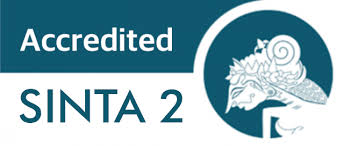Dialektika Sains, Tradisi dan al-Qur’an: Representasi Modernitas dalam Tafsir Rahmat karya Oemar Bakry
DOI:
https://doi.org/10.29240/alquds.v5i2.3394Keywords:
Tafsir Rahmat, Oemar Bakry, ModernityAbstract
Dialectic of Science, Tradition and the Qur'an: Representation of Modernity in Tafsir Rahmat by Oemar Bakry
The problem of interpretation in Indonesia which still refers to popular variation works impacts other understanding works ignored. This rejection has implications for the lack of disclosure of the peculiarities of an interpretation that can contribute to determining the method of interpretation in Indonesia. Tafsir Rahmat by Oemar Bakry is one of the interpretations that are rarely expressed in its content so that aspects of modernity are not revealed. This study aims to show parts of modernity in the Tafsir Rahmat in the form of dialectics between science, tradition, and the Qur'an. This research uses qualitative methods with content analysis as a data analysis tool. This research shows that Bakry provided a different view in the translation process by using modern terms to offer a breadth of understanding and ease. Science and technology are used to find wisdom (hikmah) and proving the truth of the Quran. The spirit of renewal carried by Bakry is also evident from the critical response to the traditions carried out by the people of Indonesia. The peculiarities in interpretation and translation that Bakry did were enough to make Tafsir Rahmat an object of study for dialectics to occur among researchers. It also impacts the dissemination of the content of this interpretation faster and affects the popularity of Tafsir Rahmat.
Downloads
References
Abdullah, Taufik. Sekolah dan Politik: Pergerakan Kaum Muda di Sumatra Barat 1927-1933. Diterjemahkan oleh Muhammad Yuanda Zara. Yogyakarta: Suara Muhammadiyah, 2018.
Adekayanti, Sri. “Metodologi Penafsiran Oemar Bakry (Studi Kitab Tafsir Rahmat).†UIN Sunan Kalijaga Yogyakarta, 2007.
Aigbodioh, Jacob A. “A Response to Helen Lauer’s Critique of the Tradition Versus Modernity Dichotomy.†Kamla Raj Enterprises 9, no. 2 (2017): 79–85. https://doi.org/10.1080/0972639X.2011.11886630.
Annisa, Firly. “Hijrah Milenial: Antara Kesalehan dan Populism.†MAARIF 13, no. 1 (2018): 38–54. https://doi.org/10.47651/MRF.V13I1.11.
Aziz, Thoriqul, Ahmad Zainal Abidin, dan Muthmainnatun Nafiah. “Tafsir Nusantara dan Isu-isu Global: Studi Kasus Relevansi Pemikiran Hamka tentang Keadilan Sosial, Kesetaraan Gender dan Pluralisme.†Refleksi 19, no. 2 (30 November 2020). https://doi.org/10.15408/REF.V19I2.16791.
Azra, Azyumardi. “The transmission of al-Manar’s reformism to the Malay-Indonesian world: The cases of al-Imam and al-Munir.†Studia Islamika 6, no. 3 (1999): 75–100. https://doi.org/10.15408/sdi.v6i3.723.
Baihaki, Egi Sukma. “Penerjemahan Al-Qur’an: Proses Penerjemahan al-Qur’an di Indonesia.†Jurnal Ushuluddin 25, no. 1 (2017): 44. https://doi.org/10.24014/jush.v25i1.2339.
Bakry, Oemar. Tafsir Rahmat. Jakarta: Mutiara, 1984.
Burhanudin, Jajat. Islam dalam Arus Sejarah Indonesia. Jakarta: Kencana, 2017.
Campanini, Massimo. The Qur’an: The Basics. Diterjemahkan oleh Oliver Leaman. London: Routledge, 2016.
Farooqui, N. K., Mohammed Fauzan Noordin, dan Roslina Othman. “Ontology matching: A case of English translation of Al-Quran Tafsir.†In Proceedings - International Conference on Information and Communication Technology for the Muslim World 2018, ICT4M 2018, 1–6. Institute of Electrical and Electronics Engineers Inc., 2018. https://doi.org/10.1109/ICT4M.2018.00010.
Federspiel, Howard M. Kajian al-Qur’an di Indonesia: dari Mahmud Yunus hingga Qurasih Shihab. Diterjemahkan oleh Tajul Arifin. Bandung: Mizan, 1996.
Gusmian, Islah. Khazanah Tafsir Indonesia, dari Hermeneutika Hingga Ideologi. Yogyakarta: LKiS, 2013.
———. “Tafsir al-Qur’an di Indonesia: Sejarah dan Dinamika.†Nun: Jurnal Studi Alquran dan Tafsir di Nusantara 1, no. 1 (2015). https://doi.org/10.32459/NUN.V1I1.8.
Hussin, Mohamad, dan Muhammad Hakim Kamal. “Translation of al-Quran into Malay Language in the Malay World.†IJISH (International Journal of Islamic Studies and Humanities) 4, no. 1 (2021): 32–50. https://doi.org/10.26555/IJISH.V4I1.3322.
Latif, Abd. “Spektrum Historis Tafsir al-Qur’an di Indonesia.†At-Tibyan 3, no. 1 (2020): 55–69. https://doi.org/10.30631/ATB.V3I1.14.
Noer, Deliar. The Modernist Muslim Movement in Indonesia 1900-1942. Kuala Lumpur: Oxford University Press, 1973.
Sayyida, Sayyida, Kusmana Kusmana, Eva Nugraha, Hamka Hasan, Yudi Setiadi, dan Rahman Ahdori. “Literature Qur’an in Indonesia: Tafsir Al-Qur’an H. Zainuddin Hamidy And Fachruddin HS (Has Analysis Of The Philological Approach).†In ICIIS. Jakarta, 2020. https://doi.org/10.4108/EAI.20-10-2020.2305183.
Tamam, Ahmad Badrut. “Model Penelitian Tafsir; Studi Karya Howard M. Federspiel:†Madinah: Jurnal Studi Islam 5, no. 2 (2018): 125 – 138–125 – 138. http://ejournal.iai-tabah.ac.id/index.php/madinah/article/view/275.
Downloads
Published
How to Cite
Issue
Section
Citation Check
License
Authors who publish with AL QUDS : Jurnal Studi Alquran dan Hadis agree to the following terms:- Authors retain copyright and grant the journal right of first publication with the work simultaneously licensed under a Creative Commons Attribution-NonCommercial-ShareAlike 4.0 International License (CC BY-NC-SA 4.0) that allows others to share the work with an acknowledgment of the work's authorship and initial publication in this journal.
- Authors are able to enter into separate, additional contractual arrangements for the non-exclusive distribution of the journal's published version of the work (e.g., post it to an institutional repository or publish it in a book), with an acknowledgment of its initial publication in this journal.
- Authors are permitted and encouraged to post their work online (e.g., in institutional repositories or on their website) prior to and during the submission process, as it can lead to productive exchanges, as well as earlier and greater citation of published work (See The Effect of Open Access).









